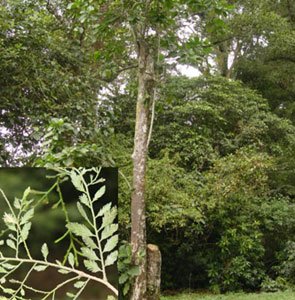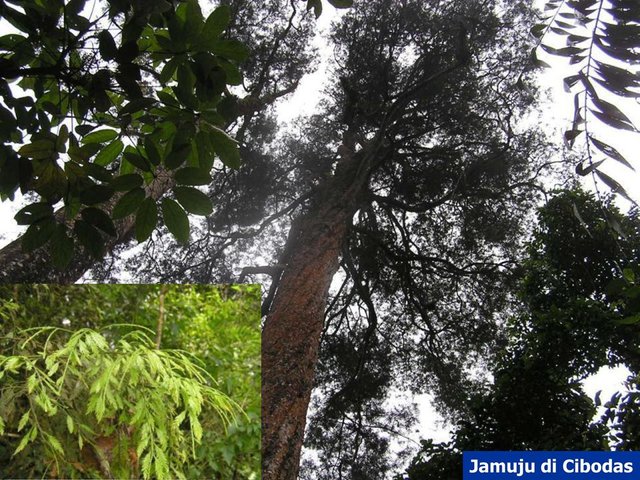Types Of Tree Species In Indonesia #1 Jamuju (Dacrycarpus imbricatus)
Jamuju (Dacrycarpus imbricatus) is also called Dew Wood. Jamuju which is a plant of Podocarpaceae family is a native of Indonesia. In addition, Jamuju was set to become the identity flora (mascot) of Purwakarta Regency, West Java. Unfortunately this widely used Jamuju timber is listed on the IUCN Red List with Least Concern status.

Jamuju (Dacrycarpus imbricatus)
In Indonesia, Jamuju is also called as Wood of Dew (Sumatera), Jamuju, Kipuiri, or Kihaji (Java), Cidadap or Cemara Bineh (Madura), and Tarupanda (Bali). Also as Kama Awama (Sumba), Majangmekar (Lombok), Oh-ru (Flores), and Wood Wind or Wood Parang (Sulawesi). Whereas in English native plants of Indonesia is named as Java Podocarpus or Malayan Yellowwood.
The Latin name of the plant of the Podocarpaceae is Dacrycarpus imbricatus (Blume) de Laub. Has several synonym names such as: Bracteocarpus imbricatus (Blume) A.V.Bobrov & Melikyan; Bracteocarpus kawaii (Hayata) A.V.Bobrov & Melikyan; Nageia cupressina (R.Br. ex Benn.) F.Muell .; Podocarpus cupressinus R.Br. ex Benn .; Podocarpus imbricatus Blume; Podocarpus javanicus (Burm.f.) Merr .; Podocarpus kawaii Hayata; and Thuja javanica Burm.f.

Leaf Jamuju (Dacrycarpus imbricatus)
The Jamuju tree (Dacrycarpus imbricatus) is able to grow as high as 50 meters. The diameter of the stem can reach between 50-70 cm. The rootstock is straight and not branched up to 20 meters tall. The tree heading often forms a dome with abundant branches and spreads. The bark of the tree is hard and rustic with a dark brown or blackish color. While the inner skin is pink to reddish brown.
Jamuju leaves are arranged in a spiral, lance-shaped shape and resemble scattered scales. The young leaves spread and resemble the skin. Reseptacles are red if cooked. Fruit solitary, fleshy, with involukrum of leaf that elongate pointed at the base, initially orange then red or purple and finally turn brown.
Jamuju (Dacrycarpus imbricatus) is native to Indonesia. In Indonesia grows spread on the island of Sumatra, Java, Nusa Tenggara, Maluku (Morotai, Seram), Sulawesi, until Papua. Besides in Indonesia the area of this plant spread includes China (Guangxi, Hainan, Yunnan), Fiji, Philippines, Cambodia, Laos, Malaysia, Papua New Guinea (Bismarck Islands), Thailand, Vanuatu, to Vietnam.
The natural habitat of the Jamuju trees is primary and secondary forest on the slopes of the mountains at an altitude between 700 - 2500 meters above sea level.

Jamuju in Cibodas
Wood Jamuju has beautiful and fine fibers that are often used as raw materials for furniture, boards, woodworking equipment, craft materials, to pulp materials. Sometimes Jamuju tree is also used as an ornamental plant or greenery.
Threats to the preservation of the Jamuju tree (Dacrycarpus imbricatus) mainly by deforestation and land clearing, especially conversion as oil palm plantations and other agricultural crops. So the more days this plant is increasingly rare and hard to find. By IUCN Redlist includes it as one of Least Concern (Low Risk) plants.
Scientific Classification Jamuju. Kingdom: Plantae. Division: Tracheophyta. Class: Pinopsida. Order: Pinales. Family: Podocarpaceae. Genus: Dacrycarpus. Species: Dacrycarpus imbricatus (Blume) de Laub.
References and pictures:
http://www.catalogueoflife.org/col/details/species/id/18158458
http://www.iucnredlist.org/details/42445/0
http://www.theplantlist.org/tpl1.1/record/kew-2755038
http://st293467.sitekno.com/article/27654/jamuju-flora-identitas-kabupaten-purwakarta.html
http://www.conifers.org/po/Dacrycarpus_imbricatus.php
http://www.asianplant.net/Podocarpaceae/Dacrycarpus_imbricatus.htm